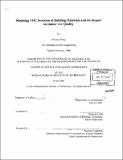Modeling VOC sorption of building materials and its impact on indoor air quality
Author(s)
Zhang, Jinsong, 1975-
DownloadFull printable version (23.98Mb)
Alternative title
Modeling volatile organic compound sorption of building materials and its impact on indoor air quality
Other Contributors
Massachusetts Institute of Technology. Dept. of Architecture.
Advisor
Qingyan Chen.
Terms of use
Metadata
Show full item recordAbstract
Sorption of volatile organic compounds (VOCs) by building materials can have significant effect on the indoor VOC concentration levels and indoor air quality in buildings. The objective of this study was to investigate experimentally the effects of environmental conditions (temperature, humidity and air velocity) on the sorption rate and capacity of three typical types of building materials (carpet, ceiling tile and painted drywall), and to evaluate existing sorption models with experimental data. A small-scale chamber test system has been developed in this study to conduct sorption tests under different environmental conditions. The sorption data collected were analyzed by three different analysis methods: the integration method, the linear Langmuir model method and the diffusion model method. The results of the integration method indicated that for the painted drywall, the differences among different environmental conditions were so small compared with the experimental uncertainties that no statistically significant environmental effect could be observed at 95% confidence level. The sorption of VOCs on ceiling tile decreased with the increase of the air velocity and temperature, but did not change significantly with the relative humidity. The sink strength of benzaldehyde under high humidity was much stronger than any other conditions. The sorption of VOCs on carpet appeared to be a diffusion-controlled process. With the increase of temperature, the diffusion coefficient increased while the partition coefficient decreased. A higher air velocity increased the sink capacity of dodecane on carpet. The relative humidity had no significant effect on the sorption of VOCs on carpet. Based on the model evaluation conducted in this study, the linear Langmuir model appeared to be suitable for painted drywall and ceiling tile while the diffusion model is more suitable for carpet.
Description
Thesis (S.M.)--Massachusetts Institute of Technology, Dept. of Architecture, 2001. Includes bibliographical references (p. 158-162).
Date issued
2001Department
Massachusetts Institute of Technology. Department of ArchitecturePublisher
Massachusetts Institute of Technology
Keywords
Architecture.